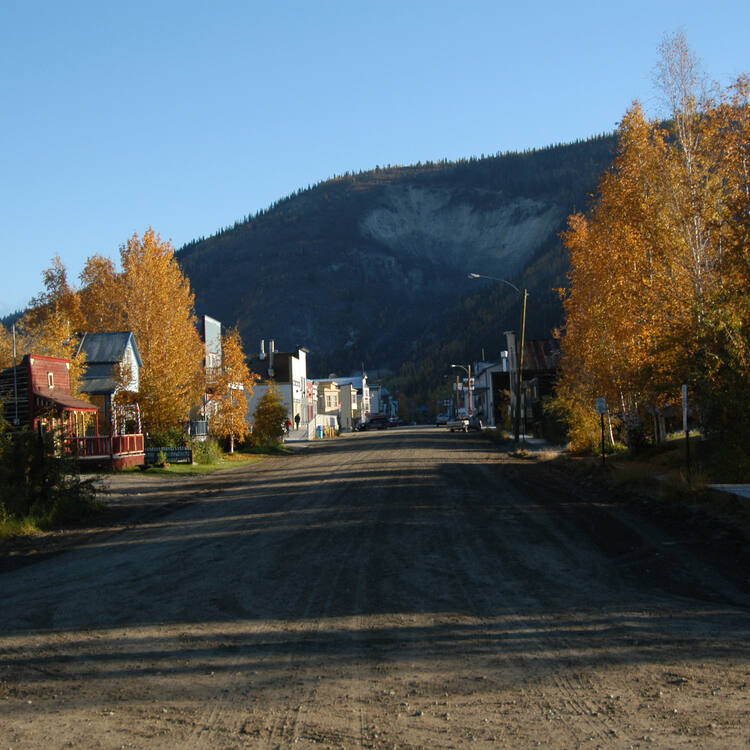Tr’ondëk-Klondike
Tr’ondëk-Klondike
Description is available under license CC-BY-SA IGO 3.0
Tr’ondëk–Klondike
Description is available under license CC-BY-SA IGO 3.0
تروندك-كلوندايك
source: UNESCO/CPE
Description is available under license CC-BY-SA IGO 3.0
特朗代克-克朗代克
source: UNESCO/CPE
Description is available under license CC-BY-SA IGO 3.0
Трондек-Клондайк
source: UNESCO/CPE
Description is available under license CC-BY-SA IGO 3.0
Tr'ondëk-Klondike
source: UNESCO/CPE
Description is available under license CC-BY-SA IGO 3.0
Outstanding Universal Value
Brief synthesis
Tr’ondëk-Klondike is located in the homeland of the Tr’ondëk Hwëch’in, in north-western Canada. It is a serial property that includes eight component parts: Fort Reliance; Ch’ëdähdëk (Forty Mile); Ch’ëdähdëk Tth’än K’et (Dënezhu Graveyard); Fort Cudahy and Fort Constantine; Tr’ochëk; Dawson City; Jëjik Dhä Dënezhu Kek’it (Moosehide Village); and Tthe Zrąy Kek’it (Black City). These have been significant resource and cultural areas for the Tr’ondëk Hwëch’in’s ancestors for thousands of years and were fundamentally transformed during the colonial occupation of these lands. Collectively, the geographical, structural, and archaeological evidence of the Tr’ondëk-Klondike serial property represents a rare and exceptionally preserved tangible illustration of dramatic modifications of land use, settlement patterns, and economy caused by the rapid and large scale of the colonising incursion of newcomers into the ancestral land of the Tr’ondëk Hwëch’in in search of gold and precious minerals. It also testifies to the intense upheaval that impacted the Indigenous people between 1874 and 1908, their dispossession from, and marginalisation in, their ancestral land, as well as their response and adaptation to the progressive colonial affirmation of the newly established Dominion of Canada. The component parts are also places where, through the endurance and revival of traditions, the Tr’ondëk Hwëch’in have fostered and maintained their distinct cultural identity.
Criterion (iv): Tr’ondëk-Klondike includes archaeological immovable remains, built structures and settlement patterns that illustrate the dramatic encounter triggered by the feverish search for precious metals between the Indigenous population and outsiders in a sub-arctic region, the colonial affirmation of the latter over the lands, resources and people, and the Indigenous people’s response to these events, in the late 19th century. Tr’ondëk-Klondike stands out as a very rare occurrence and provides remarkable evidence of growing colonial influence within a concentrated timeframe – from the construction of the first commercial fur-trading post at Fort Reliance in 1874, to the Klondike Gold Rush of 1896-1898, and, ultimately, the consolidation of colonial authority by 1908.
Integrity
Tr’ondëk-Klondike falls entirely within the homeland of the Tr’ondëk Hwëch’in. All the elements necessary to demonstrate the integrity of Tr’ondëk-Klondike – composed of encampments and harvesting sites, buildings, artefacts, and buried archaeological features – are found within the boundaries of the serial property, which is of adequate size to convey the property’s Outstanding Universal Value. Key elements of the landscape setting that provide functional links among component parts are included in the buffer zones, whilst expansive views and viewsheds from component parts over the riverine landscape, the surrounding hills and mountains that contribute to the understanding of the Outstanding Universal Value are part of the wider setting. As a whole, the property does not suffer from the adverse effects of development or neglect. The physical evidence that transmits the Outstanding Universal Value of Tr’ondëk-Klondike is in good condition and the property’s component parts are protected and managed under appropriate legislation and policy, with no component part exposed to unplanned or unregulated developments.
Authenticity
The authenticity of Tr’ondëk-Klondike is confirmed in the location and setting, changing land uses, and patterns of settlement by the Tr’ondëk Hwëch’in in response to the incursion of foreigners into their homeland. The property includes evidence related to both foreign colonial actors and Indigenous people that demonstrates extreme and rapid socio-economic change, as well as an active continuation of cultural traditions, resource use, and established settlement patterns. The authenticity of Tr’ondëk-Klondike is supported through Tr’ondëk Hwëch’in’s stories and oral history about the property, the assessment and reporting on the archaeological and historical resources, and archival and documentary records. Authenticity is also confirmed by language and other forms of intangible heritage, such as place names and the traditions, laws and customs of the Tr'ondëk Hwëch'in known as ‘Tr’ëhudè’, and the landscape setting and views from and over the Tr’ondëk-Klondike serial property.
Protection and management requirements
The property is subject to a strong and comprehensive legislative and jurisdictional framework, across four levels of government, that protects the historic and archaeological resources of Tr’ondëk-Klondike. Protection and management of the serial property is secured through Tr’ondëk Hwëch’in, territorial, federal, and municipal legislation and policies. Tr’ondëk Hwëch’in’s legislation is consistent with traditional governance, traditional practices, community planning, and conservation policies.
Territorial, federal, and municipal laws and policies contribute to the protection, conservation practices, management, and legal recognition of community-based planning and formal designation of historic sites. All component parts are designated as either national, territorial, or municipal historic sites or protected burial sites, or identified in the Tr’ondëk Hwëch’in Final Agreement, which outlines provisions of protection and management. The Memorandum of Understanding (MoU) concerning the Joint Management and Protection of Tr’ondëk-Klondike and the “Tr’ondëk–Klondike World Heritage Site Management Plan” provide a framework for the four levels of government that have regulatory, management, or administrative responsibilities for the property. The management plan describes principles, objectives and responsibilities of each partner and relies on existing management plans for individual designated heritage sites.
Long-term protection and management challenges for the property include the effects of climate change and other environmental factors; the decision-making process has been strengthened to avoid threats from mineral exploitation.
